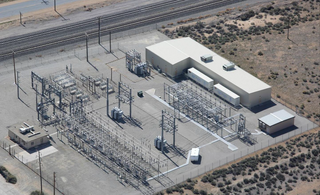
Energy storage is the capture of energy produced at one time for use at a later time to reduce imbalances between energy demand and energy production. A device that stores energy is generally called an accumulator or battery. Energy comes in multiple forms including radiation, chemical, gravitational potential, electrical potential, electricity, elevated temperature, latent heat and kinetic. Energy storage involves converting energy from forms that are difficult to store to more conveniently or economically storable forms.

Grid energy storage is a collection of methods used for energy storage on a large scale within an electrical power grid. Electrical energy is stored during times when electricity is plentiful and inexpensive or when demand is low, and later returned to the grid when demand is high, and electricity prices tend to be higher.

Peaking power plants, also known as peaker plants, and occasionally just "peakers", are power plants that generally run only when there is a high demand, known as peak demand, for electricity. Because they supply power only occasionally, the power supplied commands a much higher price per kilowatt hour than base load power. Peak load power plants are dispatched in combination with base load power plants, which supply a dependable and consistent amount of electricity, to meet the minimum demand.
A virtual power plant (VPP) is a cloud-based distributed power plant that aggregates the capacities of heterogeneous distributed energy resources (DER) for the purposes of enhancing power generation, trading or selling power on the electricity market, and demand side options for load reduction.

Tesla, Inc. is an American multinational automotive and clean energy company headquartered in Austin, Texas. Tesla designs and manufactures electric vehicles, battery energy storage from home to grid-scale, solar panels and solar roof tiles, and related products and services. Tesla is one of the world's most valuable companies and, as of 2023, is the world's most valuable automaker. In 2022, the company had the most worldwide sales of battery electric vehicles, capturing 18% of the market. Through its subsidiary Tesla Energy, the company develops and is a major installer of photovoltaic systems in the United States. Tesla Energy is also one of the largest global suppliers of battery energy storage systems, with 6.5 gigawatt-hours (GWh) installed in 2022.

The lithium iron phosphate battery or LFP battery is a type of lithium-ion battery using lithium iron phosphate as the cathode material, and a graphitic carbon electrode with a metallic backing as the anode. Because of their lower cost, high safety, low toxicity, long cycle life and other factors, LFP batteries are finding a number of roles in vehicle use, utility-scale stationary applications, and backup power. LFP batteries are cobalt-free. As of September 2022, LFP type battery market share for EVs reached 31%, and of that, 68% was from Tesla and Chinese EV maker BYD production alone. Chinese manufacturers currently hold a near monopoly of LFP battery type production. With patents having started to expire in 2022 and the increased demand for cheaper EV batteries, LFP type production is expected to rise further and surpass lithium nickel manganese cobalt oxides (NMC) type batteries in 2028.

The energy sector in Hawaii has rapidly adopted solar power due to the high costs of electricity, and good solar resources, and has one of the highest per capita rates of solar power in the United States. Hawaii's imported energy costs, mostly for imported petroleum and coal, are three to four times higher than the mainland, so Hawaii has motivation to become one of the highest users of solar energy. Hawaii was the first state in the United States to reach grid parity for photovoltaics. Its tropical location provides abundant ambient energy.
Kauaʻi Island Utility Cooperative (KIUC) is an electric cooperative located on the island of Kauaʻi in Hawaiʻi. With 35,000 member-owners represented by a nine-member board of directors, it is the only electric cooperative in the state of Hawaii, serving the only island in Hawaii not served by an electric utility controlled by Hawaiian Electric Industries.

A Tesla Supercharger is a 480-volt direct current fast-charging technology built by American vehicle manufacturer Tesla, Inc. for electric cars. The Supercharger network was introduced on September 24, 2012, with six Supercharger stations. As of April 2023, Tesla operates more than 45,000 Superchargers with more than 5,000 stations worldwide, an average of over 9 chargers per station. As of April 2023 there were 1,966 stations in North America, 2,069 in the Asia/Pacific region, and 985 in Europe. Supercharger stalls have a connector to supply electrical power at maximums of 72 kW, 150 kW or 250 kW, depending on the Supercharger generation.

Gigafactory Nevada is a lithium-ion battery and electric vehicle component factory in Storey County, Nevada, US. The facility, located east of Reno, is owned and operated by Tesla, Inc., and supplies the battery packs for the company's electric vehicles. If fully built out, the building will have the largest footprint in the world.

The Australian electricity sector has been historically dominated by coal-fired power stations, but renewables are forming a rapidly growing fraction of supply.

The Tesla Powerwall is a rechargeable lithium-ion battery stationary home energy storage product manufactured by Tesla Energy. The Powerwall stores electricity for solar self-consumption, time of use load shifting, and backup power. The Powerwall was introduced in 2015 with limited production. Mass production started in early 2017 at Tesla's Giga Nevada factory. As of May 2021, Tesla has installed 200,000 Powerwalls.

Tesla Energy Operations, Inc. is the clean energy division of Tesla, Inc. that develops, manufactures, sells and installs photovoltaic solar energy generation systems, battery energy storage products and other related products and services to residential, commercial and industrial customers.

A battery storage power station is a type of energy storage power station that uses a group of batteries to store electrical energy. Battery storage is the fastest responding dispatchable source of power on electric grids, and it is used to stabilise those grids, as battery storage can transition from standby to full power in under a second to deal with grid contingencies.

The Tesla Semi is a battery electric Class 8 semi-truck by Tesla, Inc. The truck is powered by three motors, and is claimed by Tesla to have approximately three times the power of a typical diesel semi truck, a range of 500 miles (800 km), and operate at an energy use of less than 2 kWh/mi (1.2 kW⋅h/km).

sonnen GmbH is a company in the energy industry headquartered in Wildpoldsried in the district of Oberallgäu, Germany. It produces home energy storage systems for private households and small businesses. The company is considered the market leader in Germany and additional international markets. Moreover, it is the center of a community for supplying power from renewable energies.
The Hornsdale Wind Farm is an electricity generator in the locality of Hornsdale in the south-west of the Narien Range, north of Jamestown, South Australia. It consists of 99 wind turbines with a generation capacity of 315 megawatts (422,000 hp). The plant is owned and operated by Neoen, a French renewable energy company.
Hornsdale Power Reserve is a 150 MW grid-connected energy storage system owned by Neoen co-located with the Hornsdale Wind Farm in the Mid North region of South Australia, also owned by Neoen.
The Tesla Megapack is large-scale rechargeable lithium-ion battery stationary energy storage product, intended for use at battery storage power stations, manufactured by Tesla Energy, the clean energy subsidiary of Tesla, Inc.














